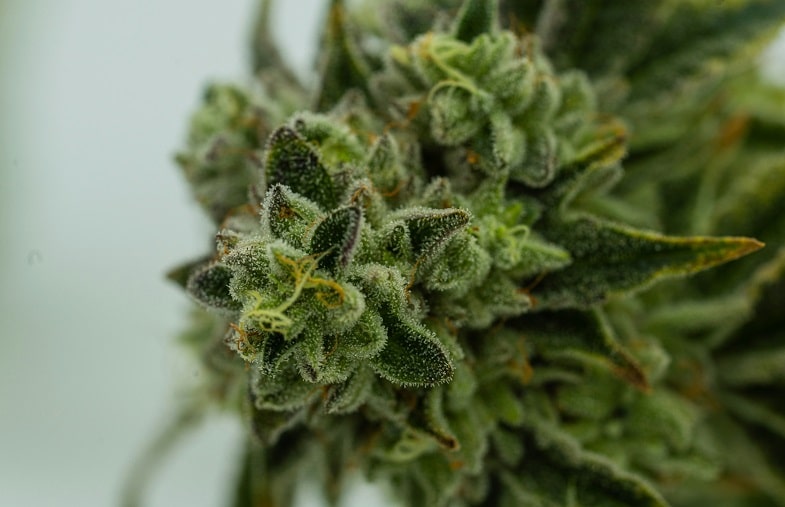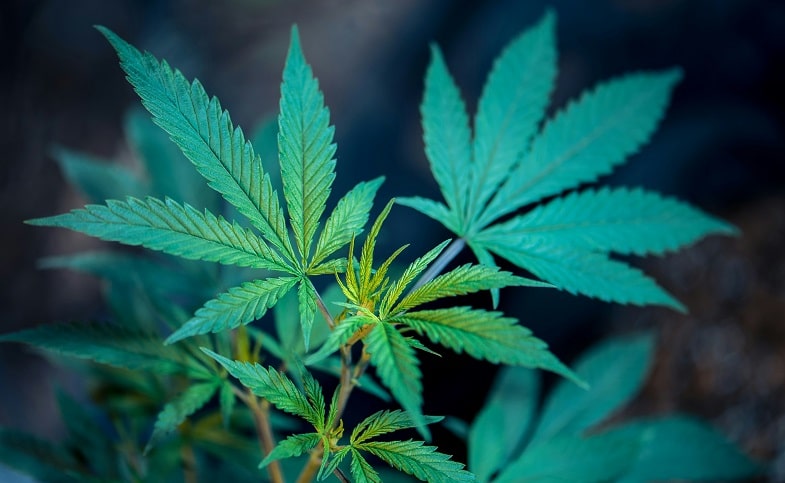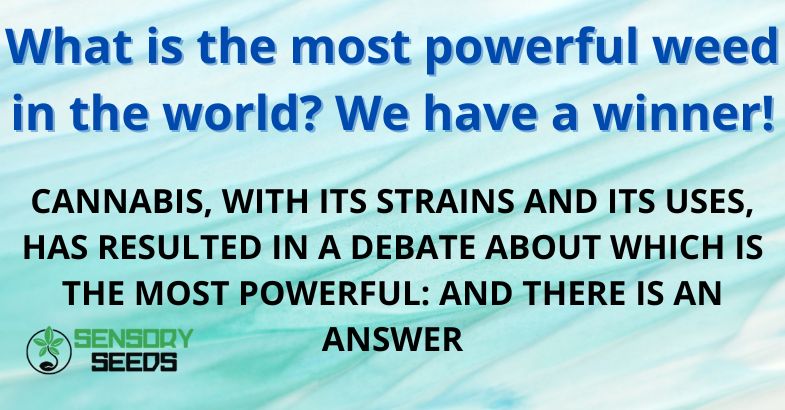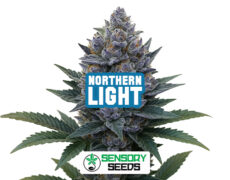Published on: 05/03/2024
CANNABIS, WITH ITS STRAINS AND ITS USES, HAS RESULTED IN A DEBATE ABOUT WHICH IS THE MOST POWERFUL: AND THERE IS AN ANSWER
Over the years, we have seen a significant evolution in the quality and potency of available cannabis strains, the result of advances in genetics, plant breeding and selection, as well as a growing consumer demand for increasingly refined and powerful products.
The potency of a cannabis strain is generally measured by its tetrahydrocannabinol (THC) content, the main psychoactive compound found in the plant. The most recent research has highlighted how today’s best varieties can boast THC percentages that vary between 25% and 30%+.
This article offers an in-depth and updated vision of the panorama of the most powerful cannabis varieties in the world, without, however, wanting to invite the use of cannabis which, let us remember, constitutes an offense in Italy, but only to give a picture of the current situation regarding “the grass”.
Read also: Why does cannabis cause red eyes?
How is the potency of cannabis assessed?
The potency of cannabis is a fundamental concept for defining and classifying the different varieties of this plant. The primary criterion used to measure potency is the content of tetrahydrocannabinol (THC), the main psychoactive compound found in the cannabis plant. THC is responsible for the psychoactive effects that cannabis is known for, such as euphoria and altered sensory perception.
In terms of measurement, a cannabis strain is considered “high THC” when the percentage of this compound exceeds 20%. The most potent strains on today’s market often exceed 25% THC, with some exceptions reaching or even exceeding 30%. These high levels of THC are the result of sophisticated cultivation and genetic selection techniques, aimed at intensifying the psychotropic effects.
THC works differently depending on the individual due to factors such as personal tolerance level, body chemistry and method of consumption: while for some users a high percentage of THC can result in a rewarding experience, for others can lead to less desired effects, such as anxiety or disorientation.
But the potency of cannabis is not calculated only on the basis of the percentage of THC. Other cannabinoids, such as cannabidiol (CBD), play a role in influencing the consumer experience, often mitigating or modulating the effects of THC. Furthermore, the terpene profile of the plant, responsible for aroma and flavour, contributes to the so-called “entourage effect”, the synergistic interaction between the chemical compounds present in cannabis.
THC remains the main parameter for evaluating the potency of a cannabis variety, but other factors such as other cannabinoids and terpenes should not be overlooked, parameters that influence the complexity and nuances of each variety.


What are the ‘strongest’ cannabis strains (and which is the most potent)
In the panorama of cannabis varieties, some stand out for their exceptional THC content, the result of years of research and development, as well as genetic selection aimed at maximizing potency and the desired effects.
One name that stands out on this list is “Chemical Bride,” a strain that reaches up to 27% THC. This strain stands out for its complex flavor profile and impressive buds. Another example is “Royal Gorilla,” which also boasts a THC level of 27%. This strain is prized for its balance of Sativa and Indica genetics and calming effects.
“Green Gelato” represents another important variety: originally from the San Francisco Bay area, it has a THC content that can exceed 25%. It is a strain renowned for its stimulating effects and its sweet and pungent flavor.
“Gorilla Glue #4” is another strain well known among enthusiasts for its unique history and for having won numerous awards in international competitions. This variety is considered the most potent in the world and stands out for its resinous flowers and its high THC content, even in the light version. Its THC percentages, regarding the illegal variety, range from approximately 27 to 30%, while the CBD quantities for the legal Gorilla Glue variety are around 22%.
It competes with Gorilla Glue #4, the “Bruce Banner #3” strain, which has 27% THC.
Finally, the “Amnesia Haze” variety has gained worldwide fame for its high THC content, which varies between 22% and 24%: it is highly appreciated for its citrus taste and stimulating and intense effects.
These strains represent only a small portion of the broad spectrum of strains available on the market, each with its own unique characteristics and effect profile. Continuous research and innovation means that potent new strains emerge regularly, offering ever richer and more diverse experiences to enthusiasts around the world.
At the moment, therefore, “Gorilla Glue #4” is on the throne: but who knows how long it will remain at the top!
What are the trends in cannabis potency
Over the last half century, the world of cannabis has undergone a change both in terms of the potency of available strains and consumption trends. Studies indicate that the potency of cannabis, measured as a percentage of THC, has increased significantly, far exceeding levels recorded in the 1970s and 1980s. This increase is due to several factors: improved cultivation techniques, targeted genetic selection and growing consumer demand for stronger varieties with a more intense effect.
For example, the adoption of more sophisticated indoor growing methods, the use of optimized lighting and nutrients, and the careful selection of strains with high levels of THC have contributed to creating very potent cannabis strains, which is also a concern in the medical field: high concentrations of THC, in fact, can cause problems that should not be underestimated at all.
With the increase in legalization and the reduction of the stigma associated with cannabis use, more and more people are approaching this world, often with a specific interest in high THC strains. This has led to a broadening of the consumer public and a greater variety in preferences and consumption patterns.
While high-THC strains have more of a market for their intense effects, the growing diversity in consumer consumption and tastes promises an even more varied and personalized future in the world of cannabis, but raises questions related to safety.
Legal Cannabis vs. High THC Cannabis
Distinguishing between legal strains, often called “light weed”, and those with a high THC content, often illegal, is essential not only for legal reasons, but also for the different applications and effects they can offer.
Legal cannabis, which is becoming established in numerous countries, is mainly characterized by a high content of Cannabidiol (CBD) and a low level of THC. CBD is known for its therapeutic effects, such as pain relief and anti-inflammatory potential, without causing psychoactive effects. As a result, legal cannabis is often used for medicinal and therapeutic purposes, offering benefits without the psychotropic effects associated with THC. In the UK, consumption is prohibited except in specific approved pharmaceutical products.
On the other hand, high THC cannabis strains are those that significantly exceed the 20% THC threshold. These strains are sought after for their potent psychoactive effects, which can include euphoria, deep relaxation, and altered sensory perception, but use of these strains can lead to serious side effects, such as anxiety or paranoia.
The legalization of cannabis in various parts of the world is leading to an expansion and diversification of the market. While some consumers prefer legal strains for their therapeutic benefits without psychoactive effects, others seek out high-THC strains for more intense recreational experiences (but sale and consumption are often illegal)
Effects and risks associated with THC
Tetrahydrocannabinol (THC) is responsible for a range of effects that can vary based on its concentration, method of consumption and individual tolerance of the consumer. Understanding the effects and potential risks associated with THC is important for responsible and informed consumption.
The best-known effects of THC include euphoria, a general feeling of well-being and happiness, and altered sensory perception. These can manifest themselves through increased sensitivity to colours, sounds and taste and a sense of deep relaxation. Some consumers also describe improved creativity and imagination.
But there are several risks associated with consuming THC, especially at high levels. Side effects may include anxiety, paranoia, confusion, and disorientation, particularly in sensitive or inexperienced individuals. Some studies have also highlighted that excessive and prolonged use of high-THC cannabis can contribute to long-term mental health problems, such as psychosis or addiction, in susceptible individuals. A study published in The Lancet and lasting several years highlighted how the risk of incurring psychosis is three times greater for cannabis users compared to non-users.
Additionally, THC use can have effects on motor coordination and concentration, making activities such as driving or operating heavy machinery potentially dangerous.
Read also: THC and CBD Microdosing: everything you need to know


In conclusion
In this article, we have seen how advancement in cultivation techniques and genetics has led to a significant increase in the potency of THC, satisfying the demand of an increasingly informed and demanding market.
At the moment, the most potent strain can be considered Gorilla Glue #4, but it’s easy to think that new, even more potent strains will arrive soon.
The increase in potency of cannabis is the result of cultivators and researchers in the field crossing different strains, continually pushing the boundaries of what is possible.
Ultimately, the cannabis landscape is constantly in flux, with developments reflecting evolving scientific knowledge, consumer tastes and legal regulations. We will see further progress and changes, with new strains, applications and consumption methods emerging in an attempt to satisfy the public: but what is of greatest interest to the medical field is the use of legal cannabis to combat serious health problems.
If you are passionate about the topic and a collector, on our Sensory Seed site you can find cannabis seeds of various types, of the highest quality, which will enrich your collection!
Takeaways
The potency of a cannabis strain is primarily determined by its content of tetrahydrocannabinol (THC), the main psychoactive compound. The most potent strains today can exceed 30% THC, thanks to advances in breeding and genetic selection.
Some of the most potent cannabis strains currently on the market include “Chemical Bride,” “Royal Gorilla,” and “Green Gelato,” with THC contents around 27%. However, “Gorilla Glue #4” is considered the most potent in the world, with levels ranging from 27% to 30%.
Over the years, the potency of cannabis has increased significantly, surpassing the levels of the 1970s and 1980s. This is due to improvements in cultivation techniques and growing consumer demand for more potent strains.
It is important to distinguish between legal cannabis, characterized by a high cannabidiol (CBD) content and low THC, often used for therapeutic purposes, and high THC varieties, sought after for their intense but potentially risky psychoactive effects.
The effects of THC vary based on concentration, method of consumption and individual tolerance. They can include euphoria, altered sensory perception, but also risks such as anxiety, paranoia, and mental health problems, particularly with excessive use.
Questions answers
How is the potency of cannabis assessed?
The potency of cannabis is generally measured by its content of tetrahydrocannabinol (THC), the main psychoactive compound found in the plant. A variety of cannabis is considered ‘high THC’ when the percentage of this compound exceeds 20%. The most potent strains on today’s market often exceed 25% THC.
What are the most potent cannabis strains?
In the panorama of cannabis strains, some stand out for their exceptional THC content, such as ‘Chemical Bride’ with up to 27% THC, ‘Royal Gorilla’ with a THC level of 27%, and ‘Green Gelato’ which can exceed 25% THC. ‘Gorilla Glue #4’ is considered the most potent in the world, with THC percentages ranging from 27 to 30%.
What is the difference between traditional cannabis and light cannabis?
Distinguishing between legal strains, often called ‘light weed’, and those with a high THC content is essential for legal reasons and for the different applications and effects they can offer. Legal cannabis is mainly characterized by a high Cannabidiol (CBD) content and a low level of THC, while high THC varieties significantly exceed the 20% THC threshold and are sought after for their powerful psychoactive effects.









